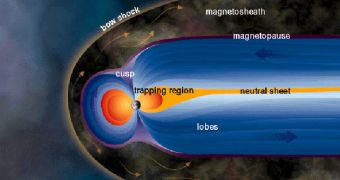A collaboration of research institutes and private companies in the United States recently managed to gain new knowledge into how our planet's magnetosphere protects us from solar winds.
As the Sun explodes, turns and churns, it emits jets of highly-energetic particles known as the solar wind towards our planet as well.
But Earth is capable of deflecting the incoming attack through the use of a force field-like section of the atmosphere, called the magnetosphere.
This structure is capable of redirecting the solar winds around our planet, essentially ensuring the survival of all complex life here. Without it, we would undoubtedly die, astrophysicists say.
In fact, it is widely agreed upon that the magnetosphere and the ozone layer are the two main factors that allowed for the appearance and development of complex life on our planet.
The interactions that develop between Earth's magnetic field and the solar winds have recently made the target of a new investigation, which was conducted with the NASA Interstellar Boundary Explorer (IBEX) spacecraft.
The machine, launched on October 19, 2008, is a part of the American space agency's Small Explorer Mission, and has thus far proven to be extremely useful.
The work was conducted by scientists at the Southwest Research Institute (SwRI) in San Antonio, Texas, the Lockheed Martin Space Systems Company Advanced Technology Center (ATC) in Palo Alto, California, and a host of other institutes as well.
“These are fantastic first images of the important region where the solar wind piles up as it deflects around the Earth’s magnetic field,” says David J. McComas of the new, detailed IBEX data.
“It is particularly satisfying that we were able to use a spacecraft built for a different purpose to unwrap a mystery that has long eluded us,” adds McComas, who is the principal investigator of the IBEX mission.
He is also an assistant vice president at the SwRI Space Science and Engineering Division. The exper explains that IBEX looks at the global interactions that develop between the solar wind and the interstellar medium.
“Without the Earth’s magnetosphere, which extends outward into space, the highly energetic charged particles carried by the solar wind could strip away some of Earth’s atmosphere,” adds Stephen A. Fuselier.
“The exchange of electrical charges between the solar wind and the outer reaches of the Earth’s atmosphere is one of the causes of atmospheric loss, but the Earth’s magnetosphere blocks the solar wind from penetrating close to the planet,” adds the expert.
“Thus, the charge exchange interaction takes place far away from the Earth, where the very outer reaches of the atmosphere extend beyond the protective magnetic field,” concludes the expert, who is the lead investigator for Lockheed's IBEX-Lo sensor.

 14 DAY TRIAL //
14 DAY TRIAL //